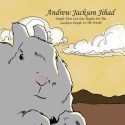|
Over in the bluegrass / banjo thread, one of the goons thought it'd be a good idea to do a collaboration. I keep meaning to follow up on it, and I will. However, considering all of the truly weird instruments in this thread, (if not discussed already), a collaboration would probably be hilariously entertaining. May even sound good, who knows.
|
|
|
|

|
| # ? Apr 23, 2024 08:27 |
|
Just wanna say a huge thanks to the OP for this thread - I just bought 2 tin whistles - and largely because of the ukulele thread, I have been playing ukulele for around 2 years (2 years officially in August). I also bought a bunch of guitars and a couple banjos and really music has given me new ways to be social, expressive, and most of all, happy.
|
|
|
|
quote:Edit: ended up getting an autoharp. Pics to follow. Groovy, fun instruments! Glad you're already talking fingerpicking; not that these sound bad strummed, but it's the picking where you really get some cool and distinctive effects. I've been reading this book recently:  Note that it's not at all a "how to play" manual, it's a book on tweaking them for best sound/handling, converting to different settups, etc. Beware: these things are highly customisable and it's pretty rare that serious hobbyists leave them in stock condition, so if you get this $20 book there's a danger you'll be posting here next month saying "yeah, I just re-felted last week to a C/F pentatonic settup, added a 37th string, and lowered my bar action." quote:Got my Xaphoon in the mail today. Woodwinds are hard! I think I'll have to go walk down in the woods and honk the poo poo out of this thing to learn proper mouth control. Don't want to the neighbors to think I'm raping goats up here. Definitely a danger. Do you have any reeded woodwind experience? If no, you might see if any of your friends who play clarinet or saxophone can help you tweak your technique. Good call on the xaphoon, neat little things. What colour did you get? quote:Just wanna say a huge thanks to the OP for this thread - I just bought 2 tin whistles - and largely because of the ukulele thread, I have been playing ukulele for around 2 years (2 years officially in August). I also bought a bunch of guitars and a couple banjos and really music has given me new ways to be social, expressive, and most of all, happy. All goon snarkiness aside, this is really awesome to hear. I've learned some pretty cool stuff on SA, so it's great to hear that other goons have learned stuff that has actually made their lives better. Rough day at work, trying to get my car sold before the registration expires, and prepping to go next week to Burlington for the Vermont Piper's Gathering: North America's most comprehensive alternative bagpipe event. For context, alt-pipes are anything other than the Great Highland Bagpipe, and arguably the uilleann pipe. I'll look to take a bunch of pics and do a nice post in this thread about all the crazy bagpipes there. In the meantime, a short piece on a simple trad instrument, and also DIY candidate: Pibgorn  Yes, the pervy comic strip from that *gams!* guy stole its name from this otherwise totally respectable Welsh instrument. This is the Welsh version of a pretty consistent class of hornpipes found across much of Europe and down into parts of Asia. It's a simple cylindrical bore pipe with a single reed and six fingerholes and a thumbhole, so actually not too unlike the primitive clarinets covered last week. These are limited in range to an octave, but the repertoire is based around that anyway.  This is what a primitive single-reed looks like: literally a piece of reed/cane with a vibrating tongue cut into it on three sides So far as makers, John "Glenydd" and John Tose build them, and a couple years back someone mentioned Gafin Morgan was working on an inexpensive plastic one (there's a pic of him playing such a cheapie on Wikipedia). I've had trouble finding these guys in the past on Google, so if you need to get ahold of them, I'd go through Kilbride or ask on Chiffboard if anyone there knows their phone# or emails. See here for pics of various makers' wares. Speaking of Kilbride, he has an awesome blog on making your own: http://www.pibgyrn.com/ Hasn't been updated in a while, but it's good basic data. I actually had cut down a goodly amount of elder branches (the recommended wood) when I lived in Seattle as a teenager, but never got motivated enough to turn it into pipes.  Note also that, though the historical attestation behind this is awfully patchy, there are folks who stick a pibgyrn into a bag, add a drone, and make a "Welsh bagpipe". Historical or a-, it's still a cool sounding instrument.  Clips: - http://www.youtube.com/watch?v=Pj6YesxUNjo Some basic solo pibgorn - http://www.youtube.com/watch?v=WJshThjqpJ0&feature=related Welsh band Calan with a pibgornist on the mic - http://www.youtube.com/watch?v=ANs-mwQ9CsE Welsh bagpipes, with some heavy drums and indie filmage; in general, there are some great YT clips that come up under "welsh bagipe" search - http://www.youtube.com/watch?v=jJt9MHt0TJo Pibgorn's cousin, the Basque alboka. A cool double-hornpipe  I'm getting a few more instruments lined up for posts; anyone have any requests in what direction to lean, or pieces you've been wanting to see but haven't yet? I also have a couple more goons I'm hitting up for electronica and synth instruments to balance all this folkstuff I bring in.
|
|
|
|
I was curious about Irish flute but it sounds like smaller-handed people can have trouble with one. So I figured I could try making one to see if I could play it. I used the instructions on Doug Fipple's site. He makes actual professional-quality PVC flutes that sound a heck of a lot better than mine. Mine isn't too terrible though! It's mostly in tune with itself at least, and I can reach all the fingerholes. My embouchure cut is not perfect yet and the C# to D transition usually fails but I'm working on it. In case anyone's curious how a $2 PVC flute made by a complete non-professional in a couple of hours can sound, I made a lovely .wav of me playing the thing: http://www.mediafire.com/?v3iea39ge29b76c disclaimer: I do not play well Anyway, it's good enough to let me determine that I could probably play a real one! Thanks, musical instrument thread!
|
|
|
|
TapTheForwardAssist posted:Groovy, fun instruments! Glad you're already talking fingerpicking; not that these sound bad strummed, but it's the picking where you really get some cool and distinctive effects. Seeing as I'm a tinkering hobbyist, I have no doubt that this will be happening. As far as fingerpicking goes, I'm not quite there yet, familiarizing myself with the instrument, but by way of demonstrating how quickly one can become listenable on this instrument, here's a quick recording of Jo karjalan kunnailla lehtii puu that I put together this morning after having a total of maybe an hour on this instrument so far. It strikes me as an instrument that is easy to learn and difficult to master, and I dig that. The strings are laid out chromatically except the very bassest ones, so it should pluck similarly to a keyboard, it's just a matter of being able to associate the strings with the notes, then learning enough notation. I'm excited for this weird instrument that isn't as difficult to play as a loving theremin, and which I can play with my dog in the house (he hates theremin). Though theremin remains my first love. Someday I will do a mashup like this Theremin and Electric Kantele performance.
|
|
|
|
Given the above autoharp success, I'll cover a related instrument, which should appeal to both our otakus and our bangraphiles: Taishōgoto (大正琴), Japanese Banjo, Bulbul Tarang, Benju Or, "what if a zither made sweet, sweet love to a typewriter?"   Again, a long story I'll make short (there's a great journal-style article I'm summarising), a Japanese musician was sent out by his government around 1900ish to go study Western music. While out and about, he saw the various "gizmo harps" that people were desperately patenting and trying to sell, and of which the autoharp is one of the only survivors because most of the others were just silly. On returning to Japan, he created an odd sort of dulcimer with a bunch of typewriter keys and named it after then-emperor Taisho (koto meaning "zither"). These were apparently crazy popular at the time, studied in school, etc. And somehow the instrument got exported to India, where as early as the 1930s-1940s or so it was being used for Indian film soundtracks, which is actually a huge and serious genre over there. Around the same time, it ended up in Baluchistan and gained ground, but blown up to massive proportions and with added drones.  I've owned I think at least two Indian ones, and one or two Japanese ones, and all of them I got dirt cheap and sold dirt cheap in the 1990s, since nobody knew much about them. Then again, I really haven't seen any of these just sitting at a pawnshop in years. I'm sure in Japan they're all over the drat place, since when I click around Japanese music store sites they have whole sections with dozens of models (check this, and this). The Japanese ones pop up on eBay pretty cheap (search keyword "taisho*"), but with like $70 shipping from Japan. New ones in Japan seem to run $400-600 for the higher-quality ones, though I don't doubt you can find plywood beaters cheap. The Indian ones go a slow at $60 new from wholesalers on eBay, and a vintage one might be even cheaper. Probably the cheapest would be from an eBay seller who has no idea what it is, so if you're good at guessing keywords, or just following the "Zither" section for a few weeks, you might luck out.  Clips: - http://www.youtube.com/watch?v=CVhygJskXcs Some very trippy playing on a Suzuki taisokoto - http://www.youtube.com/watch?v=rxC3uF2vIms Impressive improvisation, makes this sound quite like an old-school koto - http://www.youtube.com/watch?v=XvpCE8JhliM Old virtuoso shows how be backed early Bollywood films Rather odd instrument, but an interesting way to access Japanese or Indian music by-the-numbers, and unlikely you'll have much competition unless you live in either of those parts of the world.
|
|
|
|
TapTheForwardAssist posted:Definitely a danger. Do you have any reeded woodwind experience? If no, you might see if any of your friends who play clarinet or saxophone can help you tweak your technique. Good call on the xaphoon, neat little things. What colour did you get? Nope, no reed experience at all. To quote clarinetist Ferris Bueller, "Never had one lesson!" I took it to work yesterday and after everyone left and I was working alone I made a game attempt at figuring out how to make a sound. It's hard! I can barely choke out a note. I've been watching Youtube videos to try to get a sense of how much mouth pressure, etc, I need but that's hard to judge. I guess there's only one thing to do:
|
|
|
|
Bolkovr posted:Nope, no reed experience at all. To quote clarinetist Ferris Bueller, "Never had one lesson!" Indeed, good attitude. I would particularly recommend: choose one note, and work at it, just a couple minutes at a stretch, several times a day, all week, just to get one clean note and hold it. Don't try anything fancy, don't wiggle your fingers around, just seat your fingers properly covering the holes and experiment with your breath until you can get a note and hold it. Again, an hour of practice broken into 3-minute chunks three times a day for a week beats an hour of honking once a week, so don't be afraid to set it down and pick it up in a few hours. I'd also recommend you drop into the Xaphoon forum to say hello and get some noob tips; it's not terribly active, but they'd probably enjoy having someone new say hello. I'll go and cover another wind instrument, since I have one of these coming in the mail: Panpipes, or panflutes - or "quills" in the Old Deep South  First off, this is another one of those instruments where, gosh darn it, I learned some new things while reading up on this topic, so I'll get to that shortly. The panpipes is an extremely simple instrument spread all over the world. It's pretty much just an array of tubes (bamboo, cane, whatever) cut to various lengths to change their pitch, and blown across like a beer bottle. Modern folks probably mostly associate these with Romania, Ancient Greece, and the Andes mountains. In all honesty, I also associate them with crystal-wearing New Agers and with crappy Muzak, but that's not really a slam on the instrument itself. You can't really discuss panpipes without mentioning Zamfir. Dude was a Romanian musician discovered by a Swiss researcher, and brought West in the 1970s to do a film soundtrack. The man went on to do a lot more film soundtracks, such as Picnic at Hanging Rock, Once Upon a Time in America, Karate Kid and most recently Kill Bill. He's sold like 4 million albums and brought the instrument a lot of visibility, but also gave it kind of a kitschy vibe it doesn't really rate.  On the grittier side, and this was really new to me, panpipes or "quills" as they were called were also a traditional African American instrument, that survived just long enough for some of the earlier recorded blues players to still be playing them. Yes, blues on panpipes. Not kidding, you'll see in the clips, and really good article here. The most famous quills player recorded was probably Henry Thomas, who you'll instantly recognise in the clips because his songs have been covered, among others by Canned Heat, though they dicked it up and used a flute for "Goin' Upcountry" where the quills solo was on the original. Like the fife, the panpipes is either dead or nearly so, so it's sad to see a traditional American genre fade out.  So far as buying panpipes, if you want something really higher-end Panflute Jedi (a great resource overall) has a page on recommended quality 'pipes. If you want to go under $100, Aulos (also marketed as Rhythm Band in the US) sells as low as $89 or lower for a synthetic set and are widely recommended. If you're tighter on cash, Groth sells synthetic panpipes as low as $27 for a 10-hole, and the Hall glass (pyrex) pipes for $50. If you want maple (the most popular wood) for not too expensive, Brad White at Pan-flute.com has starter sets with all the gear and instructional materials for $99, and has a pentatonic scale ("no wrong notes", same as Native American flute) option for $65. Before anyone asks about the Andean cane ones: I would just hold off on those until you know how to play well. The cane seem a bit harder to play, and also you have to know what you're buying to tell the difference between a wall hanger and a good one, so I'd stick to more known-quantities at first. Do note though, these are also not hard to build, so by all means google yourself up some plans, get some PVC, and go to town.  - http://www.youtube.com/watch?v=K-VnXxdngig&feature=related Dom Flemmons of the Carolina Chocolate Drops covers an old Henry Thomas tune, with a panflute on a neck-holder. CCD is an awesome band, does all old-school African American string-band music. So yes, they can get away with calling the fiddle tune "Colored Aristocracy", not to mention all the other otherwise unmentionable old song titles; you can guess what the tune "Shave a Dead Man" used to be called. - http://www.youtube.com/watch?v=3Qo9R5kDZWY Here's the original version of the Thomas tune that got covered at Woodstock. - http://www.youtube.com/watch?v=zcUUhK-pF_8 Can you play Bach on it? Survey says yes. - http://www.youtube.com/watch?v=DC-qVU58Nk4 Kill Bill just woudln't have been the same without Zamfir.  -
|
|
|
|
Yay, taishogoto. I've wanted one for years, it's so wonderfully silly. My dream is to join one of these huge taishogoto orchestras staffed only by elderly women, typing away: http://www.youtube.com/watch?v=6AnDN1b-6Fk Anyone else have a sanshin?  I have been playing for a few years, it's a lot of fun. Everyone should get one.
|
|
|
|
TapTheForwardAssist posted:Again, an hour of practice broken into 3-minute chunks three times a day for a week beats an hour of honking once a week, so don't be afraid to set it down and pick it up in a few hours. Yeah, I think that's the tack I'm going to have to take: just get to where I can blow a C reliably. Right now it's 50% steady C, 50% agitated goose. I will say that I find the sensation of having my top teeth directly on the mouthpiece to uncomfortable. I need to get over that. On the plus side, I went ahead and bought a second Xaphoon so I can keep one in the car.
|
|
|
|
Bolkovr posted:Yeah, I think that's the tack I'm going to have to take: just get to where I can blow a C reliably. Right now it's 50% steady C, 50% agitated goose. I will say that I find the sensation of having my top teeth directly on the mouthpiece to uncomfortable. I need to get over that. On the plus side, I went ahead and bought a second Xaphoon so I can keep one in the car. You want a mouthpiece cushion, they will make you so much happier.
|
|
|
|
There have been several other posts outlining bamboo flutes, but I wanted to share another perspective. Bansuri - Or the Indian transverse bamboo flute  In many respects this instrument is just the irish flute you may have already read about. They come in a range of keys and price ranges. You can find cheapy ones to learn on or you can actually invest a pretty penny in a flute made from a perfect and aged piece of bamboo would, grown on the graves of enlightened buddhist monks. One of the main differences from other common flute constructions is the 7th hole on the end. This is for your sharp 4th (referred to as Tivra Ma in Hindustani), and learning how to use it well is a big key to transitioning octaves and allowing meend (note bending, slides, glissandi) with all of your notes. Historically, the bansuri has a solid place as a folk instrument and as an iconic image in Hindu religion. The image of Krishna seducing the Gopi milkmaids with his bansuri playing is a popular one.  It is only within the last 60-70 years that the bansuri has been taken up as a serious instrument for playing Hindustani classical music. This can mostly be attributed to Pannalal Ghosh, who as a student of the maihar gharana, took bansuri seriously enough to perfect the technique necessary for genuine raga development with all the acoutrements and ornaments necessary for Hindustani, particularly bending notes pitches. Coming from such a serious lineage, others took notice and the bansuri has further gained popularity and credibility. For context, Ghosh's guru was Ustad Allaudin Khan, who was also the guru of Ali Akbar Khan (his son) and Ravi Shankar (who ended up becoming his son in law). With open holed flutes, the full range of microtonal possibilities are open to those willing to spend the time working on it. Here is an example of the current bigtime bansuri player, Hariprasad Chaurasia. Take note of how gracefully he can slide from pitch to pitch. Thats some smooth fingerwork. https://www.youtube.com/watch?v=U5h19sgkuGk So if you want to find a bansuri there are plenty of good places to look. I started off on one in the Key of G, and paid somewhere around 30-40 dollars for mine, which was made by Bansi Jeff. I ordered mine from Buckingham music, but I know you can find them many places. The Ali Akbar College of Music store is also a good place to buy Indian instruments in general and bansuri's, they take great care in what they import and buy. When you get it, what should you start practicing? How to properly hold the instrument and make a good sound. I used this book to get up and running, and if you live near Chicago, Lyon Leifer is a nice guy, he'll teach you lessons if you ask (he charges of course). When I was visiting a friend there I took two sessions with him and he instantly spotted and set my hand positions straight.  Lyon is sitting all the way on the left, take a look at his hand position. When I started playing, I had a strong tendency to twist my left hand in, so that the flute was almost resting along my index finger, and for certain fingers I had to twist my wrist. This is bad, you want your hand position to be such that your wrists are steady and fairly fixed, and that you can easily lift your fingers from the flute without losing stability in your grip. Once you have basic hold down and can make a sound, work on keeping a steady tone and begin climbing to higher notes. You can reach higher octaves by blowing harder, but you'll start to learn that this is undesirable, and that your embouchre is a much better way to increase the speed of your air stream without causing your volume to shoot up and be shrill. When you're ready to start climbing up and down, you next want to work on making a smooth transition from one octave to the next across the break.  (There are additional fingerings for higher notes, lemme know if you want them, I only know up to high C, and on my flute thats a really high note, but I'm sure there are fingerings for higher pitches, particularly if you're on a deeper flute) So the scale you're going to want to practice (assuming a flute keyed to C) is the G major scale, basically C major scale with an F sharp. In Indian terms, you have Tivra Ma (on the chart its the Ma with a line on top). Notice how there are alternate fingerings for Tivra Ma. What you want to practice when going up/ascending, is when you get to Ga/E, rather than playing Tivra Ma/F# with the all holes open fingering, you want to play it with the all fingers down fingering, that way you can glissandi/meend from Tivra Ma/F# to Pa/G when you need to and it'll sound much smoother. On the way down/descending, you use the other, all holes open fingering for Tivra Ma/F#, allowing you to slide down to Ga/E. At first getting the right alternate fingerings for your break can be awkward, but it will pay dividends later. So that should get you started on the path. At first you want a flute keyed to C or G#, but later on you can play with different tonics. The end goal of the top level bansuri players is to play the larger, lower keyed flutes. These larger flutes can take some considerable "wingspan" on yours hands, so you'll need to work up to it. Part of the fun of these different instruments is that some of them come from deep tradition, and you can actually spend a lifetime learning new modes and ragas on this modest little instrument. Indian Classical Music is open to you without tracking down some other, more finnicky Indian instruments or finding a vocal coach. Also, one things thats helped me on this is that its easy to pick up and put down. So I can do short little bursts of practice several times throughout the day as I get bored. Slow scale, fast scale, minor keys, long tones, I just try to change it up but do a little regularly, and I feel happy with the progress I'm getting. If anyone goes this path and needs some raga chat, lemme know! Figuring it out from books alone can be a slog. I'm not super deep in and have only been practicing in a few of them, but I can help you orient yourself to start walking. Yiggy fucked around with this message at 10:37 on Jul 30, 2011 |
|
|
|
I'm going to reach a bit and cover an instrument that probably not many goons are going to dash out and buy this week, but it's a drat awesome instrument and worth keeping in the back of your head. Also I'm not buying one anytime soon because I move too much, so I'm not concerned about driving up prices by bringing it more attention. Clavinet  There were various kinds of early acoustic keyboards, basically all of which but the piano have been largely killed off by competitors. Virginal, clavichord, harpsichord, spinnet, clavier, claviharp, etc. A whole variety of ways to strike a key and act upon a string. I'm particularly fond of the clavichord (invented in the 14th C.) where the keys swing little blades into the strings. Not a lot of sustain, but really neat tone. Clavichord had been going downhill for a few centuries, when in 1968 Hohner inexplicably started producing electric clavichords, giving up 14 years later. They apparently intended it originally for classical music, but the main way the instrument got visibility was through jazz music, with Stevie Wonder himself playing the instrument in concerts. They haven't made the instrument since 1982, but they turn up decently commonly on eBay and whatnot, and there's a cottage industry of upgrading and refurbishing them, particularly at, unsurprisingly, Clavinet.com. The instruments go around a grandish, depending on condition, so still much less expensive than most acoustic clavichords.  Old-school acoustic clavichord - http://www.youtube.com/watch?v=Tq_kGC0cXbg Hohner's original advert album, showing what the company expected people would be using their product for - http://www.youtube.com/watch?v=t6yEdv6qymc Stevie Wonder showing how the clavinet actually got used - http://www.youtube.com/watch?v=uDLD6XxuVBMM amateur Claviduck jamming on clavinet with a wah pedal - http://www.youtube.com/watch?v=sEDZHQXdM_gVk Bach on an acoustic clavichord 
TapTheForwardAssist fucked around with this message at 03:26 on Aug 1, 2011 |
|
|
|
Not a learning recommendation since I doubt any of us can easily find a working one, but the dolceola is the awesome lovechild between a clavichord and an autoharp: One of many weird fretless zithers of that area, and found a very, very small popular niche in early recordings of gospel singers.  - http://www.youtube.com/watch?v=zg0KI7m2_ic some old-school gospel - http://www.youtube.com/watch?v=bt0nJe8sIss&feature=related Blues tune If anyone else has a dork-on for restoration projects, this guy's blog about totally refurbishing a dolceola is worth seeing: http://www.fretlesszithers.com/ss/dolc/index.html quote:Anyone else have a sanshin? Dammit, there was just a kid who posted a new thread in A/T asking about shamisen, I directed him to this thread, and a mod closed his. But I haven't seen him pop back up. Would you be inclined to do a post about that instrument? And someone still needs to do a post on CBOMs and mando-cellos.
|
|
|
|
Does anyone play the melodica?
|
|
|
|
Planet X posted:Does anyone play the melodica? Anyone who's anyone, why?
|
|
|
|
Planet X posted:Does anyone play the melodica? I've messed with one in the past, owned I think an alto Hohner, and my uncle played one for a bit. Anything in particular you want to know? Melodica  The melodica was invented from whole-cloth by Hohner back in the 1960s. It's a slightly novel variant on an overall popular and varied family of "free reeds"; essentially a small piano accordion keyboard but with a mouthpiece to blow air rather than a bellows. These are mainly popular with softer indie bands, and make occasional appearances in reggae and ska (apparently popularised by Rastafarian keyboardist Augustus Pablo).  As you see in the pic, there are two basic kinds (all the ones in the pic are Hohners): the smaller ones tend to be separated buttons (vice a true piano keyboard). This means that they're easier to play two-handed up to your mouth, since both hands can act, but not as commonly played as a two-hand keyboard fed by a tube. The smallest ones are also higher pitched and with less range, but you do save on bulk. For brands: Hohner is the classic, and I would personally lean towards those. I've heard mixed things about the Schoenhut, and don't know about the Yamaha. You can get used Hohners of various sizes between $19-40, so it's not like these are terribly pricey.  - http://www.youtube.com/watch?v=c_zJ0lTjQjs Acoustic Asteroids cover with melodica; this is pretty much how they're used in indie bands overall; piano-style melodica but played one-handed from the mouth - http://www.youtube.com/watch?v=Z0Qwfh6tCYk&feature=related Reggae-style vamping on a smaller melodica - http://www.youtube.com/watch?v=nVtNk_KjcAI&feature=relmfu Some Bach played two-handed on a flat surface, fed by a mouth tube. In this format, it's very much like playing a regular keyboard.
|
|
|
|
I picked up the recommended toy accordion off of amazon and its going to be
|
|
|
|
I can't remember seeing this advice for whoever it was that is learning Xaphoon (Bolkvr!) but first thing I can think of to recommend is to get a softer reed. If I recall the Xaphoon came with a 2.5 whereas when I first started on clarinet we were allocated 1.5 reeds. They're easier to get a note out of and easier to feel how steady your airflow is, but don't sound as smooth as a harder reed. I was probably playing for a year or so before I moved to a 2 and then longer again before using a 2.5 or a 3 reed. Suck on the reed for about 5 mins before you play to get it nice and wet. I think this helps swell the bamboo and shuts any airholes in the grain along the length of the reed. You can hear if there are airholes, the note will have a noisy hissy leaky quality to it. Another thing I remember doing was to run a thumbnail along with the grain of the thick part of the reed to try and close the airholes a bit with pressure. Maybe use the kind of pressure you would to crease a fold in a piece of paper, and don't go too close to the thin top part of the reed. It does take a while to break in a new reed. None of this applies if you are using synthetic reeds. Reed condition is fairly important for not sounding terrible. If your Xaphoon didn't come with tips for how to put the reed back on, I think you pretty much want to line the edge of the reed and the edge of the mouthpiece up, then drop the reed a little lower so you can see a thin band of mouthpiece. Varying this gap will change how easy it is to get a note and you'll find the sweet spot with practice. The ligature should go lower than the uncarved part of the reed and be moderately tight (hope this makes sense). I don't know how consistent reed manufacture is where you are, but occasionally I'd find a reed that was just terrible compared to others in the packet, so it helps to try a different reed sometimes. I'd usually keep a couple of reeds in circulation and never store the reed on the mouthpiece since they can go mouldy when left on. I did try synthetic reeds once but I really didn't like them, and by that stage I'd acquired a literal taste for bamboo anyway. Another thing I had trouble with when learning clarinet was the vibration of the reed would somehow reverberate in the back of my throat and drive me crazy. Then eventually I didn't notice or feel it any more. Maybe I just got used to it, or stopped doing whatever was causing it. If I played too long or blew too hard I'd find myself unable to maintain the seal at the back of my nose to stop blowing air out my nose instead of down the clarinet. It really hurts when you lose that seal and do a massive snort out of your nose! So if you start feeling fatigue, give it a break before it's too late. You get a cleaner sound if you tongue the reed between notes, I guess it depends what you're trying to play but as a beginner I was told to go "tu tu tu" to make the notes. "du du du" works as well but sounds different. If you just blow and waggle your fingers around you're guaranteed to squeak to start with. Actually if you don't know the fundamentals, I'm guessing a Xaphoon is the same, you tuck the edge of your bottom lip over your teeth and lean the reed side on that. Top teeth rest on the mouthpiece and lips seal around. It feels bad if you bite down too hard and you really don't need to chomp to get a good seal. I think if your top teeth are feeling wrong maybe you're biting down without realising it? Really it was hard for me to learn to relax my jaws and hold on moreso with my lips. If you are making a lot of hissing air noises and no sound maybe try sticking the mouthpiece further into your mouth - if I recall correctly it's not like a recorder which barely goes into your mouth, you need to give the tip of the reed room to vibrate. Or vice versa maybe if you're honking all the time, ease the mouthpiece out of your mouth a little. OH! Something from my very very first clarinet lesson came back to me, open your mouth and say "Ah" as if you're saying the first vowel in "apple". Then stick the clarinet in, your bottom lip and tongue should be about right from that position. Let me know if any of this helps! I hope I'm not remembering wrong and pulling stuff out of my arse. Stoca Zola fucked around with this message at 20:05 on Aug 3, 2011 |
|
|
|
Roxxfan posted:Wow, good stuff! Thanks for posting all that. I got my 2nd Xaphoon in the mail yesterday and I can tell the reed on this one is much better. The first one had a hole in it. And then I was stupid and cracked the reed so I need to stop by a music store and pick up some more. I will try a softer reed.
|
|
|
|
This thread got me to buy a Feadog tin whistle from a nearby music store and now I can nearly play 3 or 4 Irish folk songs I've always liked the sounds of. Thanks for the fun cheap hobby. Is there a way to play a high E on this thing that I just haven't figured out yet, though? There are a few more tunes I'd like to try but they have higher notes than I think it's capable of.
|
|
|
|
TapTheForwardAssist posted:melodica More curious than anything else. As a big fan of Augustus Pablo, I've thought about picking one up. For those that play, are you playing pretty much anything, or more minor key dub? http://www.youtube.com/watch?v=MiaekG1Q0UE Amazing, love his sound, it's too bad he isn't with us anymore. Planet X fucked around with this message at 00:06 on Aug 4, 2011 |
|
|
|
Vomax posted:This thread got me to buy a Feadog tin whistle from a nearby music store and now I can nearly play 3 or 4 Irish folk songs I've always liked the sounds of. Thanks for the fun cheap hobby. I don't have a Feadog, but my Walton's Little Black Whistle is basically the same thing but aluminum. You're talking about the E in your third octave right? The lowest E (second lowest note on the whistle) and your E2 (an octave up from that) should be easy to play. You can produce a pretty clean E in the 3rd octave, but it will take you a lot of practice to get it to come out on cue. I find it's much easier to learn the amount of force and proper tongue technique if you start an octave below, and tongue each note on the way up; one tricky thing with that is your third-octave D should be fingered 0XXXXX, so just the top finger on your left hand off. The E above that is fingered the same as lower octaves though, so XXXXX0 - the only thing that makes it an E3 is precise tonguing and breath control.
|
|
|
|
Those high note fingerings sound similar to the flute's. For an alternate fingering for E3 you may try XX00X0. If that works, then use X0XX0X for F3 and X0X000 for G3.
|
|
|
|
ChurlishToff posted:I picked up the recommended toy accordion off of amazon and its going to be Welp, the accordion I got came with a little instruction booklet. It'll give you the basic scale and a few tabs for little nursery rhyme type songs (it is, after all, built for children). Play the scale a few times to get accustomed to the motion, then try the tabs they give you. You're going to look really lame playing "London Bridge" for a few days, but it'll get you used to fingering the keys. Because I'm totally musictarded, I just went straight to using tabs. They're easy as hell to learn and you can find a lot of familiar songs. Tabs4ToyAccordions is written in the 1-7 format, but it's kind of limited. I personally like to use Harp Tabs, which is a site for harmonica music and has a huuuge selection of songs in every genre. Simply go to search, select "diatonic" under harp type, and search for whatever song or genre tickles your fancy. Most diatonic tabs are in a 4-10 format. Just subtract three from every number (4=1, 5=2, and so on), and bam, accordion tabs. It takes some getting used to, but it's honestly the best website for those too lazy to learn to read sheet music (ie: me  ). ).Note: Not every diatonic tab will work, as some will go lower than you can play, but feel free to improvise. I can usually find a way to disguise a missing note with a little tooling around. Edit: I should also mention that not every song using harmonica tabs will come out sounding nicely on an accordion. Things with lots of repetitive notes (eg Blackbird by The Beatles) tend to be the worst in this case. Grape Juice Vampire fucked around with this message at 20:48 on Aug 4, 2011 |
|
|
|
GJV, did you do the reed-taping mod I mention back on page 6? The stock toy has two reeds for each note (so four for each button, two push and two pull). Those take up a lot of air, but you can cut that in half by putting some masking tape onto one of the two reeds for each note. The other good thing about that is that if one of your two reeds is more out-of-tune than the other, you can tape the more off one and have just a well-tuned note. I still need to get around to doing a YouTube tutorial on how to tweak these, but if you pull out the metal pins to open it up it's pretty visible how these things work. Note also on page 6 I explain how you can either play tabs (as GJV advises) for song melodies/harmonies, but you can also play just chords to back up singing. I can dig around and see if I can find, or if necessary, make a chord-chart for the toy accordion.
|
|
|
|
Grape Juice Vampire posted:Rad accordion info Thanks! I'll be sure to keep that in mind when I find the need to disturb the peace via toy accordion. 
|
|
|
|
Planet X posted:More curious than anything else. As a big fan of Augustus Pablo, I've thought about picking one up. For those that play, are you playing pretty much anything, or more minor key dub? I picked one up a few weeks ago and haven't played any dub. I've been playing pretty much whatever... jazzy stuff, major key indie rock-ish stuff, funky stuff. It's a lot of fun and surprisingly versatile. I'll try to get some recordings soon. edit: at like 2:40 he's playing some triads up and down it sounds like, what the gently caress is he doing? I've been wanting to figure out how to play like that. ashgromnies fucked around with this message at 18:35 on Aug 4, 2011 |
|
|
|
TapTheForwardAssist posted:GJV, did you do the reed-taping mod I mention back on page 6? 
|
|
|
|
Planet X posted:More curious than anything else. As a big fan of Augustus Pablo... I always love it when someone takes something that's "not a serious instrument" and just blows away all the haters. Not to sound lazy, but the world has a lot of good guitarists, and it's hard to really "add" much to the world of guitar understanding unless you're just a legend or a mad genius, but if you break out of the mainstream choices, you can really forge some new sounds on overlooked gear. On vacation at the moment, so don't want to get too deep into doing a new post, but since I'm at the Piper's Gathering in Burlington, VT I'll try to get some good pics and clips of all the kinds of bagpipes while I'm here, and go on a bagpipe bender for the thread next week. We've been kind of holding out on bagpipes thus far. Any Burlington goons: smallpipes concerts this Sat and Sun nights, $15 adults, under 12 free: http://pipersgathering.org/index.shtml . Three little follow-ups from previous threads: Ichigenkin  Both to tie into our Nipponese posts, and also to the diddly-board. It's a 1-string Japanese zither, basically just a plank and some pegs. And, like the diddly-bow, played with a slide, though the Japanese monks apparently had more baller cash and thus used an ivory slide. There are very few living expert players, but a handful of folks are pulling this instrument (which has some ties to Zen musical traditions) back from the brink. Props to the dude running http://www.ichigenkin.com/ for working to get the word out. - http://www.youtube.com/watch?v=mi8rn6FIRVE Hakusenso, Summer section, for Ichigenkin 一弦琴 - http://www.youtube.com/watch?v=rn3uwiv2Hwk SUMA, Ichigenkin 一弦琴 by Minegishi Issui 峯岸一水  Buffalo drum Was at Advance Music in Burlington today, and got to try out a 22" Remo Buffalo Drum. It's basically Remo's take on the "shaman drum" or basic frame-drum with rope crossbars. Nice and solid, synthetic head. Beat on it, and drat but this thing puts out a lot of bass for a $60 drum. Tunable would be nice, but at least the synthetic head should be able to deal with all kinds of conditions. Impressed overall.  - http://www.youtube.com/watch?v=-uP1bMPdrj4&feature=related Here's the Remo 16", which is not bad, inexpensive, but not as impressive - http://www.youtube.com/watch?v=BitA4_eYQX8 Westerner doing some sort of version of traditional singing with shaman drums. To be blunt, most YT hits for "shaman drum" are going to be about this odd, so fair warning. That's no hit on the drum style itself though - http://www.youtube.com/watch?v=jywFbPZ3I4M Huh. Okay. Well, if you want to know how to do divination with a shaman drum, here's how you do it. There absolutely has to be some way to employ this in getting gullible hippie boys or girls to sleep with you. TapTheForwardAssist fucked around with this message at 20:44 on Aug 5, 2011 |
|
|
|
Yiggy posted:Those high note fingerings sound similar to the flute's. For an alternate fingering for E3 you may try XX00X0. If that works, then use X0XX0X for F3 and X0X000 for G3. Huh. I just tried XX00X0, and it does sound a little more in tune for an E3 than XXXXX0, which is flat but serviceable for a quick note. I generally don't bother with F3 and G3 on a D whistle because they're so unbelievably loud that they're not useful, but your fingerings seem to give relatively accurate pitches for them as well.
|
|
|
|
In the interest of catching back up on bagpipe options: Northumbrian Smallpipes  This type of bagpipes is one of the more modern members of the family, incorporating a lot of refinements and mechanical doo-dads from the 1800s. It probably started out as something more similar to the Scottish smallpipes (which I'll cover later) which were also small, bellows-blown, mellow-sounding pipes, but then English makers started adding keys to get more range and more chromatics. The really unusual thing about the NSP is that the chanter (melody pipe) can actually stop playing notes; the chanter has a closed end, so if you cover all the holes it'll go silent. By using a playing style where you only open one whole at a time, and by leaving just a tiny gap between covering that hole and opening the next note, you get a sharp, punctuated "stacatto" style which is distinct to the NSP.  British piper "Inky Adrian"; oddly enough, a very conservative musician and scholar who pushes for a very strict style of playing the NSP The NSP has generally had a very small but firm niche. I'm trying to recall the numbers off the top of my head, but it's something like: there have probably only been 3,000 NSP sets ever made, about 2,000 current players, and 1,000 of those live within the general Northumberland area the pipes are native to. The instrument has gotten a good grip overall since the 1960s Folk Revival, so holding up pretty well with at least one relatively famous player, Kathryn Tickell. "Famous" here in the sense that "people interested in folk music in general, not just bagpiping, might have heard of her." For pricing, you'd be looking close to $1000 for the most basic sets, and nicer sets are a few thou. Probably the best way to get a starter set would be to join the Northumbrian pipes mailing list (run from New Hampshire, oddly enough). Most folks outside Northumberland are self-taught, and there is some pretty good curriculum for such folks. If you're in the UK around Northumberland, you're golden, plenty of events and workshops and things. If you're in the US, unless you're in Seattle, Boston, etc. you'll only have a player near you by random chance.  - http://www.youtube.com/watch?v=MFYyVj6he_g Andy May, one of the modern masters - http://www.youtube.com/watch?v=y3-DXrMbKQY Amateur player with a set of three tunes - http://www.youtube.com/watch?v=9820S3eSNDM Kathryn Tickell and her Northern English band - http://www.youtube.com/watch?v=vxuhiPg66QI&feature=related Yes, you can play Bach on these EDIT: Not an NSP, but on Dunsire Bagpipe Forums there's a dude selling a set of "kitchen pipes" (small Great Highland pipes that play at a lower pitch and indoor volume) for $275. New they're $328 shipped, and this seller is tossing in a variety of accessories. Trading Post link here. Clip of the same model being played. 
TapTheForwardAssist fucked around with this message at 22:05 on Aug 5, 2011 |
|
|
|
BAMBOO FLUTE HAS COME! I ordered the flute in D, hoping to play me some white man music. http://www.eriktheflutemaker.com/Concert_Tuned_Flutes.htm Here's a fingering chart for those who also are learning http://sites.google.com/site/dougsflutes/irishflutefingeringchart It's quite fun; I've gotten lightheaded the first few days trying to figure out how to make a consistent sound with the instrument. I've finally found a technique that works for me; angling your mouth depending on how high or low you're going. I've learned the D major scale (not hard since it's keyed to it). I find I have the most difficulty hitting the low notes. The first few tries ended up becoming screeches. The clear, hollow yet solid sound that comes out of the flute is a good quality. I find the sound to be very encouraging whenever I hit a note well. All in all, I'm very happy with my purchase and look forward to music making (and learning a whole bunch more about it). Thanks TTFA.
|
|
|
|
Trip report on my Hayden Duet Concertina (the Elise from Concertina Connection). I've had it for about 3 weeks now, and it has been a lot of fun. The first big realization for me was figuring out the logic of the key placement. At first when I got it, the placements of the accidentals seemed arbitrary and random (why is the f# on a lower row than the f?). But when I figured out that it is all designed so that the same pattern gives the same type of chord everywhere on the button set, it made sense. The D major scale is just as simple as shifting the C major fingering over one button. The finger shape that gives you a C major chord is the same for D, F, G, A, and B-flat major. It is pretty genius when you realize it. The other main issue I had was it kept feeling hard to hold on to even at the smallest hand strap setting. Last night I cut some holes in the hand straps even farther down, and now it feels a lot more secure and easier to play. When playing, should I be keeping the right side still and moving the left side? Or moving the right side and keeping the left side still? Pulling and pushing both sides together feels wrong. Anyway, A++ really really enjoying it, and since my music theory and piano chops are already decent, it hasn't been too hard a switch so far. Sometimes I think I maybe should have gotten a bisonoric concertina just because it is so different from what I'm used to, but the Duet fingering gives me the ability to do accompaniment and melody together better. It is sort of a decent tradeoff between a concertina and accordion.
|
|
|
|
Thanks, thread, I bought a melodica.  It'll be worth $40 just to jam over some dub!
|
|
|
|
Hey guys, awesome thread.  I went through some of my old stuff and found a tin whistle I got at some historical place gift shop:  It's a little different from the others in this thread, the mouthpiece is metal with a block of wood instead of plastic:  D'ya think it's adequate or should I get a proper one?
|
|
|
|
That kind of mouthpiece will sound quieter and windier compared to the plastic ones, but that particular one looks messed up like the block isn't inserted all the way. It should look like this (Shaw C & Clarke D):
|
|
|
|
Augster posted:Hey guys, awesome thread. That looks very much like a "Cooper" brand tinwhistle. I picked one up not 2 months ago at Mount Vernon (George Washington's plantation) outside of Washington DC. The one I had was vaguely playable, and could be improved somewhat by squeezing the soft metal around the fipple to reshape it, test it, squeeze a different way, etc. Given that an Oak, Walton or Feadog tinwhistle is literally $8 or so, I'd recommend you get one of those whistles (in key of D) as a far better starter. After you learn whistle technique, you may be able to do some moving and squeezing on your Cooper and get it running smooth, but until you have that knowledge you'll be frustrated by your current whistle (and as withak notes, visibly yours looks even more sloppily QC'ed than usual). I wouldn't spend any extra for a booklet or CD pack with a 'whistle, since there's tons of free tinwhistle material online. Just find a seller who has the best price for a basic good-quality whistle (the article chiff & fipple presents: Guide to Inexpensive Whistles is a little dated, but still accurate), get it, and enjoy the wealth of free online instruction. quote:BAMBOO FLUTE HAS COME! I ordered the flute in D, hoping to play me some white man music. Outstanding! Erik has a great rep online, so you should be square. To both you and the above tinwhistler: it's not at all that we're trying to force folks into playing Irish, but if you have a tinwhistle, or a flute that uses same/similar fingering and is in key of D, there are 100 online English-langauge resources for Irish learning for every 5 of other traditions (Breton, Galician, Swedish, Americana, etc). Even if your goal is to play South Afrikan kwela on tinwhistle, or Bretagne an dro on your bamboo flute, you can't go wrong learning the bare basics of Irish style, and then transition over from there to whatever tradition you prefer. It's just easiest to cut your teeth on Irish with the sheer amount of tutorials free online. At this bagpiping festival I'm at in Vermont right now, Jerry Freeman had a table set up. Freeman is "the world's only professional pennywhistle tweaker"; the man's (retired, I believe) full-time job is taking Generation whistles, and a set of small files, dremels, etc. and making them more-betterer. I was dubious at first as well, but I payed $35 for his improved version of a $9 Generation F whistle, and it was absolutely worth the money. It just plays far better once it's been hand-modified for best flow. Further, the lowest key Generation makes cheap ($9-14) is the Bb, which is not the most useful key. Freeman takes Gen Bb mouthpieces, puts them on to a piece of hand-drilled copper pipe that's slightly longer, and turns them into A tinwhistles for $44. A is probably the most useful Irish key after D, and the only way to get As is as more expensive whistles, so when I saw today he was making Low As i snatched one up for that price. Completely setting aside key compatibility with other genres, Bb has been my favourite tinwhistle key, so we'll see if this Low A can take its place in my esteem... Will reply on the Hayden concertina and the melodica in a day or so, but have to get to bed since been up drinking with bagpipe players, and have a 0930 class Sunday morning on medieval bagpipe polyphony. If anyone here is interested in any kind of unusual bagpipe (anything other than Great Highland), these national gatherings (of which there are several) are loving awesome, so feel free to PM me for details. One melodica question for Planet X: what make of melodica did you get? Do you have enough chops to do reggae vamps from the get-go, or do you need any advice from the musician goons here?
|
|
|
|
I bought the student Hohner. I should have what I need already to get going at a basic level as I can generally pick stuff up by ear, but will take any advice you have.
|
|
|
|

|
| # ? Apr 23, 2024 08:27 |
|
TapTheForwardAssist posted:info Thanks! It can make a fair enough sound on the lower notes but on the higher ones it sometimes does some harmonics/overtone type stuff. It might just be me though, I can do that on my sax so I guess I need more practice controlling my whistle. Today's mah birfday so I think I'll see about ordering a new whistle. I also need help identifying some sort of reed flute that my grandfather gave me a long time ago; I'll post pics and stuff later today. Thanks again TTFA and withak
|
|
|






















